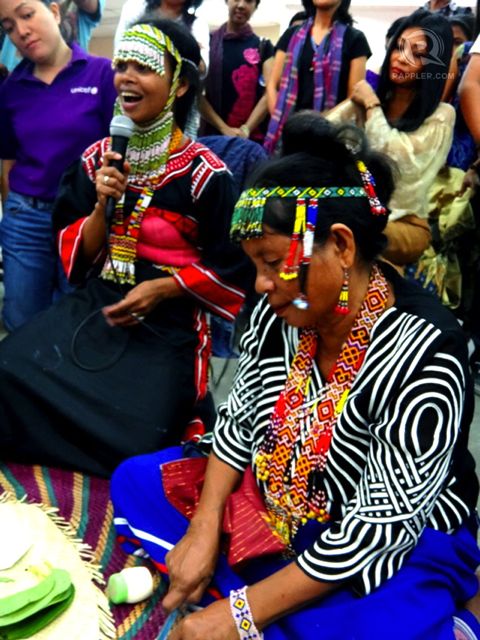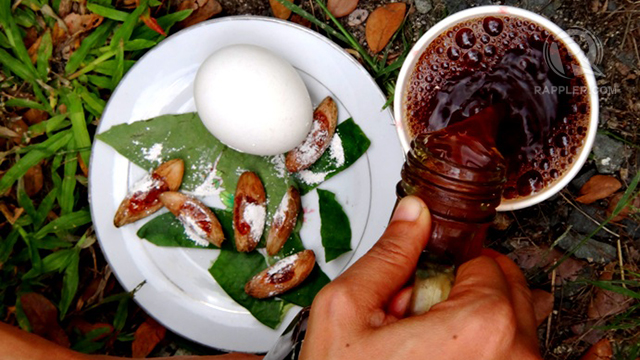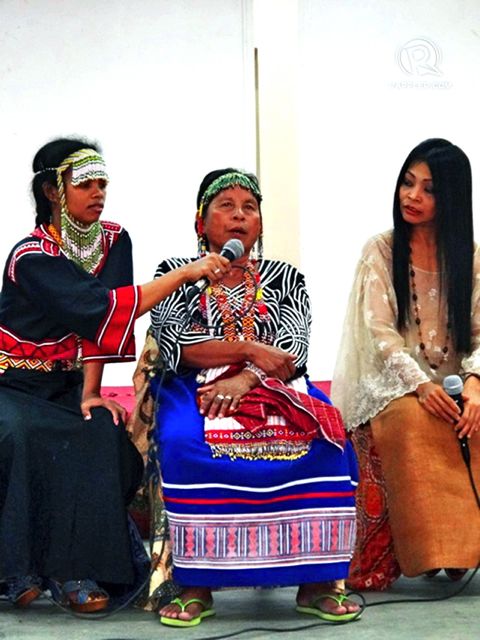SUMMARY
This is AI generated summarization, which may have errors. For context, always refer to the full article.

MANILA, Philippines – I watched as Baylan Undin’s swift, sure hands — hands that must have done this a thousand times — sliced open betel nuts, sprinkled pulverized limestone on each, and wrapped them up one by one in leaves for nganga (betel nut chewing).
This was part of the Panawagtawag, a ritual that asked permission from the unseen beings in our surroundings during that Buhay Babaylan lecture-ritual in the University of the Philippines-Diliman last January 19. The ritual was also to pay respect to her abyans (spirit familiars).
Earlier, I — along with a rapt audience of at least 70 — watched Baylan Undin offer a native chicken to these beings and spirits.
Now, after partaking of the nganga and sharing it with us, she began singing the tod-om, a Manobo song with lyrics Baylan Undin composed at that very moment. I felt her powerful voice and her words, though strange to my ears, vibrate in my chest and ribcage and send tingles through my body.

Later, this woman of 67 years exuded both a quiet authority and a childlike delight as she led us in a group dance, and passed around tuba (coconut wine) to drink and celebrate.
The babaylan, which I only read about in textbooks and heard in lectures as one of those formidable figures in history — warrior, healer, teacher, visionary, and/or priestess — was now smiling and dancing before me.
A real babaylan in the flesh; a historical character come alive.
While “babaylan” is the popularized term, different communities in the Philippines use different names. To the Ifugaos, it is the mumbaki. And to the Manobos in Agusan del Sur, Baylan Undin’s home, it is the baylan.

Lordina “Undin” Potenciano is a Manobo baylan from the mountains of La Paz, Agusan del Sur. At 20 years old, she accepted the call to baylanhood from spirit guides, one of whom was her late grandmother. She has since then been healing the sick, leading sacred rituals, and helping her community in any way she can.
Her role as a healer is particularly crucial, according to her interpreter, Robilyn Coguit Canto, a Manobo youth leader. Because of the remoteness of Baylan Undin’s mountain community, there are no nearby health facilities. Robilyn revealed that health workers have “given up on them” because of the difficulty getting to their area. (In fact, Baylan Undin took 18 hours to get to Butuan airport for her flight to Manila for the babaylan lecture-ritual.)
In her community, Baylan Undin cures common illnesses like colds and stomach aches with herbs and other natural means. She also facilitates and eases the process of childbirth. It is through chanting the gudgod, a song similar to the tod-om, but where an abyan now sings through her, that Baylan Undin is also able to find the right cure or solution.
Despite her and other baylans’ help to their community in La Paz, though, many people, even in their own community, are no longer as appreciative as before. “They have stopped believing,” Robilyn lamented.

Which was why Baylan Undin, through Robilyn, expressed her thanks more than once to the audience of 300 during the lecture and discussion part of the event as she felt “accepted despite being different.” She also felt our openness and appreciation of the ritual she led.
Musician and documenter of oral Philippine traditions Grace Nono explained that there was a need to recognize the importance of babaylans’ roles today, like Baylan Undin’s role in healing and helping her community. Doing so would help ensure that the babaylan tradition and the very real help babaylans give to their communities continue.
This musical artist herself has been keeping the babaylan tradition alive in her own way by researching and writing about the babaylan, as well as learning and performing their songs. She herself sang a haunting and powerful tod-om during the event.
Sociologist Girlie Villariba, in her article “Babaylan Women as Guide to A Life of Justice and Peace,” discussed the relevance of the babaylan in modern times. She said that Filipinos could learn from babaylans’ reverence for the sacred, as they “live and breathe the belief that ‘God is in all of us.’”

The way they heal is not just about “merely treating the infection or the illness.” The very act of healing is also considered as sacred, as it “weaves various notions of divine laws and of natural laws with those of human laws.”
So, should we encounter a babaylan, especially when we visit other parts of the Philippines, simply talking to them and acknowledging the work they do could go a long way. – Rappler.com
(To join future Buhay Babaylan lecture-rituals, go to http://buhaybabaylan.blogspot.com/ or e-mail buhaybabaylan@gmail.com.)
Add a comment
How does this make you feel?
There are no comments yet. Add your comment to start the conversation.